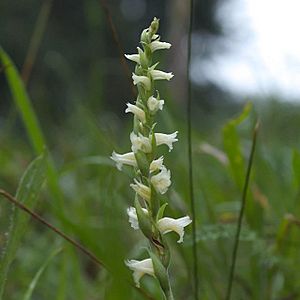Yellow nodding ladies'-tresses facts for kids
Quick facts for kids Yellow nodding ladies'-tresses |
|
|---|---|
 |
|
| Scientific classification | |
| Genus: |
Spiranthes
|
| Species: |
ochroleuca
|
| Synonyms | |
|
|
The Spiranthes ochroleuca, often known as the yellow nodding lady's tresses, is a type of orchid. This beautiful plant grows naturally from southeastern Canada all the way down to the eastern United States. It's named for its flowers, which seem to "nod" or droop slightly, like a lady's braided hair.
Contents
What is a Yellow Nodding Lady's Tresses?
The yellow nodding lady's tresses is a wild orchid species. Orchids are a very large family of flowering plants. This specific orchid is known for its tall, slender stem. It has small, creamy yellow or yellowish-white flowers. These flowers grow in a spiral pattern around the stem.
How it Looks
This orchid usually grows to be about 8 to 20 inches tall. Its leaves are long and narrow, like blades of grass. They are often found at the base of the plant. The flowers are small, usually less than half an inch long. They have a sweet, vanilla-like scent. The "nodding" part of its name comes from how the flowers often point downwards.
Where Does It Grow?
Spiranthes ochroleuca is found across a wide area in North America. It prefers specific types of places to grow. This orchid likes moist, open areas. You can often find it in meadows, along roadsides, or in open woodlands. It also grows in areas that have been disturbed, like old fields.
Its Natural Home
This orchid is native to many regions. In eastern Canada, it grows in New Brunswick, Nova Scotia, Ontario, and Prince Edward Island. In the Northeastern United States, it is found throughout the region. It also grows in the southeastern United States. This includes states like Kentucky, Maryland, North Carolina, South Carolina, Tennessee, and Virginia.
Life Cycle of the Orchid
Like all plants, the yellow nodding lady's tresses has a life cycle. It starts from a tiny seed. Orchids have very small seeds that need special help to grow. They often rely on tiny fungi in the soil. These fungi help the seeds get the nutrients they need to sprout.
How it Reproduces
Once the plant grows, it produces flowers. These flowers are pollinated by insects. After pollination, the flowers develop into seed pods. When the pods are ripe, they release thousands of tiny seeds. These seeds are then carried by the wind. If they land in a good spot with the right conditions and fungi, new plants can start to grow. This cycle helps the orchid spread and survive.

